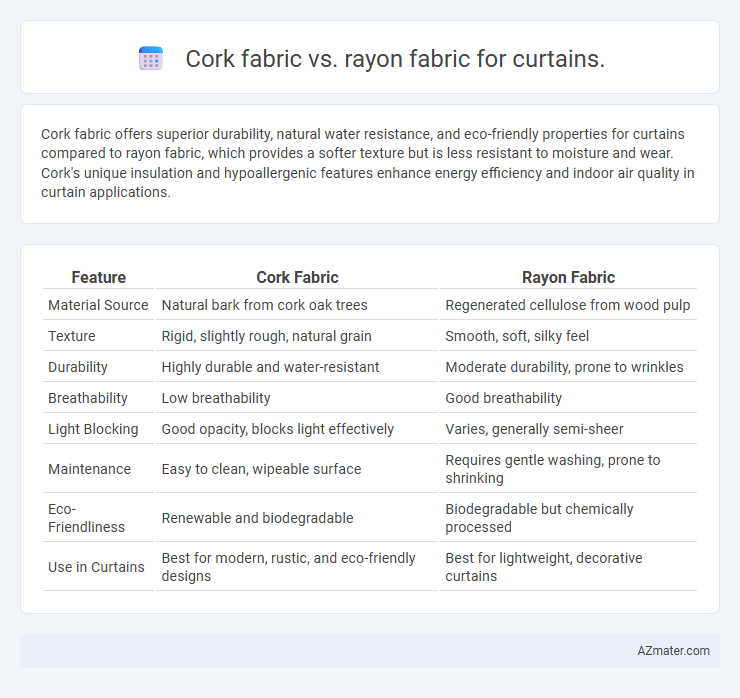Cork fabric offers superior durability, natural water resistance, and eco-friendly properties for curtains compared to rayon fabric, which provides a softer texture but is less resistant to moisture and wear. Cork's unique insulation and hypoallergenic features enhance energy efficiency and indoor air quality in curtain applications.
Table of Comparison
| Feature | Cork Fabric | Rayon Fabric |
|---|---|---|
| Material Source | Natural bark from cork oak trees | Regenerated cellulose from wood pulp |
| Texture | Rigid, slightly rough, natural grain | Smooth, soft, silky feel |
| Durability | Highly durable and water-resistant | Moderate durability, prone to wrinkles |
| Breathability | Low breathability | Good breathability |
| Light Blocking | Good opacity, blocks light effectively | Varies, generally semi-sheer |
| Maintenance | Easy to clean, wipeable surface | Requires gentle washing, prone to shrinking |
| Eco-Friendliness | Renewable and biodegradable | Biodegradable but chemically processed |
| Use in Curtains | Best for modern, rustic, and eco-friendly designs | Best for lightweight, decorative curtains |
Introduction to Cork Fabric and Rayon Fabric
Cork fabric, derived from the bark of cork oak trees, is a sustainable and durable material known for its natural water resistance and unique textured appearance, making it an eco-friendly choice for curtains. Rayon fabric, made from regenerated cellulose fibers, offers a smooth, silky feel with excellent draping qualities and vibrant color retention, ideal for stylish and lightweight curtains. Both materials provide distinct benefits in curtain applications, with cork fabric emphasizing sustainability and durability, while rayon excels in aesthetic appeal and softness.
Key Differences Between Cork and Rayon Fabrics
Cork fabric, derived from natural cork oak bark, offers durability, water resistance, and eco-friendly properties, making it ideal for curtains requiring insulation and moisture protection. Rayon fabric, a semi-synthetic fiber made from cellulose, provides a soft, smooth texture with excellent drape but lacks the water resistance and rigidity of cork. Key differences include cork's natural waterproofing and sturdiness versus rayon's breathability and vibrant dye absorption, influencing curtain performance and aesthetic appeal.
Durability Comparison for Curtain Use
Cork fabric exhibits superior durability for curtain use due to its natural resistance to wear, moisture, and UV rays, making it highly suitable for long-term exposure to sunlight and humidity. Rayon fabric, while soft and aesthetically pleasing, tends to degrade faster when exposed to sunlight and moisture, leading to potential fading and weakening of fibers. Consequently, cork fabric offers enhanced longevity and maintenance advantages over rayon in curtain applications.
Environmental Impact: Sustainability of Cork vs Rayon
Cork fabric, derived from the bark of cork oak trees, is highly sustainable due to its renewable harvesting process that does not harm the trees, making it an eco-friendly choice for curtains. Rayon fabric, while made from cellulose fibers like wood pulp, often involves intensive chemical processing and considerable water usage, raising environmental concerns. Opting for cork fabric supports a closed-loop ecosystem with lower carbon emissions and minimal waste, whereas rayon's environmental footprint is larger due to deforestation and pollution from production.
Aesthetic Appeal and Texture Analysis
Cork fabric offers a unique, natural aesthetic with a warm, organic texture that enhances curtain designs by adding depth and rustic charm, while Rayon fabric provides a smooth, silky surface with a subtle sheen, creating an elegant and luxurious curtain appearance. The tactile quality of cork fabric is firm yet flexible, making it ideal for contemporary or eco-friendly interiors, whereas rayon curtains drape fluidly and feel soft to the touch, suited for classic or modern decor settings. Aesthetic appeal in cork fabric emphasizes durability and earthiness, contrasting with rayon's lightweight, breathable nature that supports vibrant color retention and a refined finish.
Maintenance and Cleaning Requirements
Cork fabric for curtains requires minimal maintenance due to its natural resistance to moisture, stains, and mold, making it ideal for humid environments. Rayon fabric demands more care, as it is prone to shrinking and color fading when exposed to water or harsh cleaning agents, necessitating gentle hand washing or dry cleaning. Choosing cork fabric can significantly reduce cleaning frequency and extend the curtain's lifespan compared to rayon options.
Cost Comparison of Cork and Rayon Curtains
Cork curtains typically have a higher upfront cost due to the natural harvesting and processing involved, making them a premium choice for durability and eco-friendliness. Rayon curtains, being a semi-synthetic fiber, are generally more affordable with a wider range of price points influenced by quality and manufacturing techniques. When considering long-term value, cork's sturdiness may reduce replacement frequency, while rayon offers cost-effective options suitable for budget-conscious decorators.
Light Filtering and Insulation Properties
Cork fabric offers superior natural insulation and excellent light-filtering capabilities, making it ideal for curtains that require energy efficiency and moderate light control. Rayon fabric, while smooth and lightweight, provides limited insulation and allows more light to pass through, resulting in less effective light filtering. For curtains prioritizing thermal retention and privacy, cork fabric is a more suitable choice compared to rayon.
Suitability for Various Interior Styles
Cork fabric offers a natural, eco-friendly aesthetic suited for rustic, Scandinavian, and modern minimalist interiors due to its textured, organic appearance and durability. Rayon fabric, with its smooth finish and wide range of colors and patterns, complements contemporary, traditional, and eclectic styles, providing a soft, elegant drape ideal for stylish, versatile curtains. Both materials enhance interior design, with cork providing a unique, sustainable touch and rayon delivering lightweight flexibility and vibrant decor options.
Final Verdict: Which Fabric is Better for Curtains?
Cork fabric offers superior durability, natural water resistance, and excellent insulation, making it ideal for curtains in humid or high-traffic areas. Rayon fabric, while softer and more affordable, tends to wrinkle easily and lacks the structural strength required for long-lasting drapery. For curtain applications prioritizing longevity, thermal performance, and eco-friendly properties, cork fabric emerges as the better choice.

Infographic: Cork fabric vs Rayon fabric for Curtain
 azmater.com
azmater.com